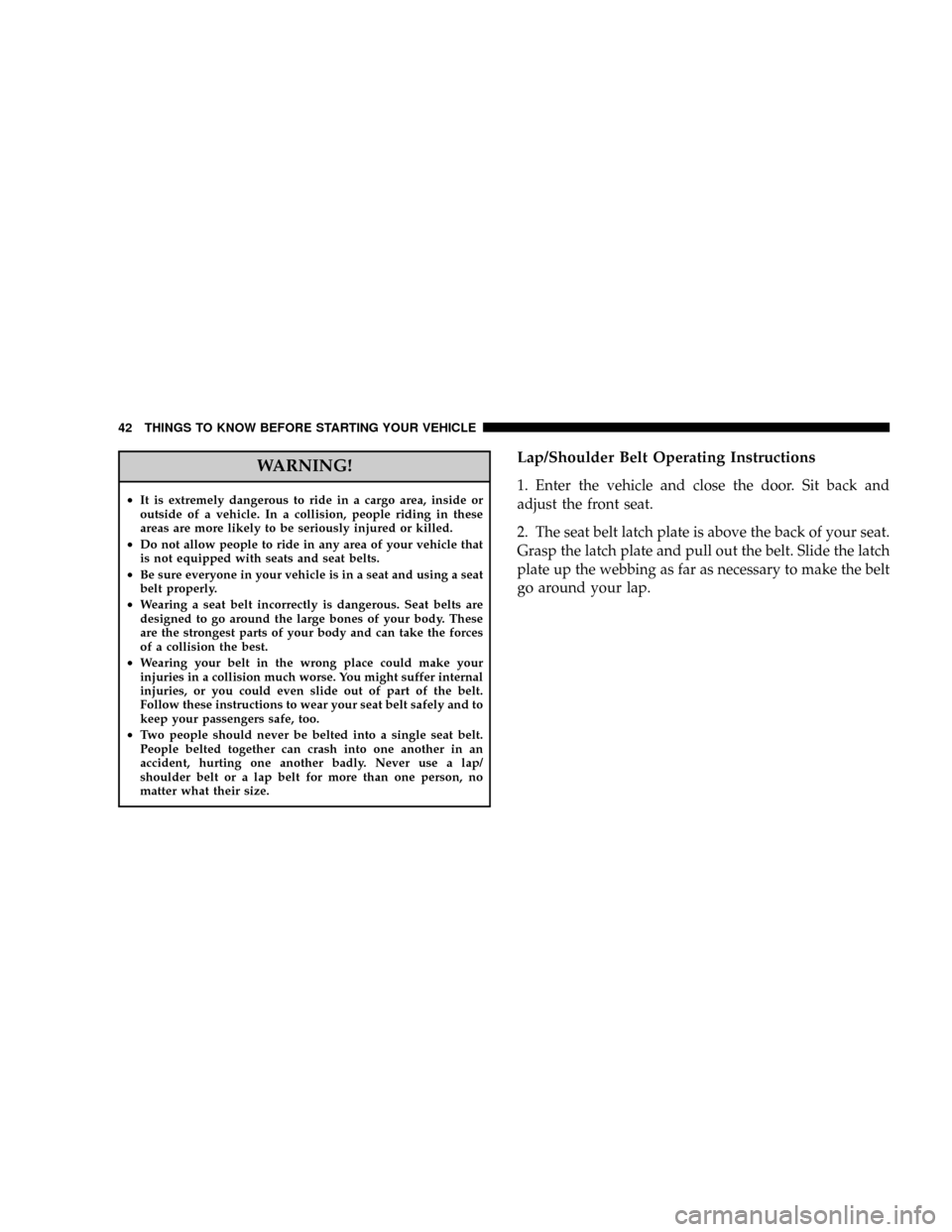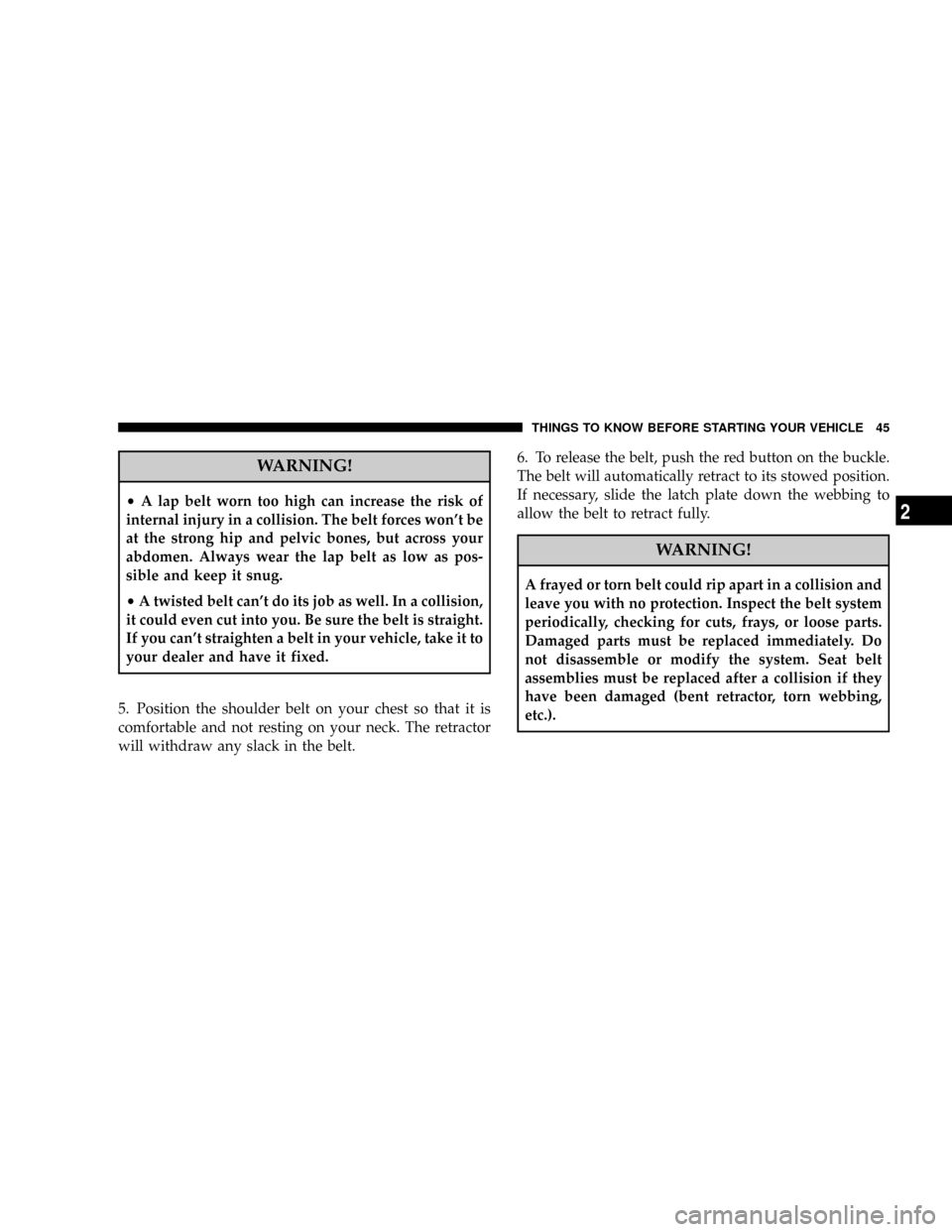Page 10 of 466

NTo Unlatch The Trunk...................24
NUsing The Panic Alarm..................24
NProgramming Additional Transmitters........25
NTransmitter Battery Service...............25
NGeneral Information....................26
mRemote Starting System Ð If Equipped........26
NHow To Use Remote Start................26
mDoor Locks............................28
NManual Door Locks.....................28
NPower Door Locks.....................29
NChild Protection Door Lock...............32
mWindows.............................34
NPower Windows.......................34NWind Buffeting........................38
mTrunk Lock And Release...................38
mTrunk Safety Warning.....................39
NTrunk Emergency Release................40
mOccupant Restraints......................40
NLap/Shoulder Belts.....................41
NLap/Shoulder Belt Untwisting Procedure.....46
NSeat Belt Pretensioners...................47
NEnhanced Seat Belt Reminder System
(BeltAlertt) ..........................47
NAutomatic Locking Mode Ð If Equipped.....49
NSeat Belts And Pregnant Women............49
NSeat Belt Extender......................50
10 THINGS TO KNOW BEFORE STARTING YOUR VEHICLE
Page 40 of 466

Trunk Emergency Release
The trunk of your vehicle is equipped with an emergency
release handle. It is located on the inside of the trunk lid,
near the latch, and is coated so that it glows in a darkened
trunk. Pull on the handle to open the trunk.
OCCUPANT RESTRAINTS
Some of the most important safety features in your
vehicle are the restraint systems. These include the front
and rear seat belts for the driver and all passengers, the
front airbags for both the driver and front passenger, the
optional supplemental side curtain airbags for the driver
and passengers seated next to a window, and the optional
supplemental front-seat-mounted side airbags. If you
will be carrying children too small for adult-size belts,
your seat belts also can be used to hold infant and child
restraint systems.
Please pay close attention to the information in this
section. It tells you how to use your restraint system
properly to keep you and your passengers as safe as
possible.
Emergency Release
40 THINGS TO KNOW BEFORE STARTING YOUR VEHICLE
Page 41 of 466

WARNING!
In a collision, you and your passengers can suffer
much greater injuries if you are not properly buckled
up. You can strike the interior of your vehicle or other
passengers, or you can be thrown out of the vehicle.
Always be sure you and others in your vehicle are
buckled up properly.
Buckle up even though you are an excellent driver, even
on short trips. Someone on the road may be a poor driver
and cause a collision that includes you. This can happen
far away from home or on your own street.Research has shown that seat belts save lives, and they
can reduce the seriousness of injuries in a collision. Some
of the worst injuries happen when people are thrown
from the vehicle. Seat belts reduce the possibility of
ejection and the risk of injury caused by striking the
inside of the vehicle.Everyonein a motor vehicle should
be belted at all times.
Lap/Shoulder Belts
All seating positions in your vehicle are equipped with
Lap/Shoulder Belts.
The belt webbing retractor is designed to lock during
very sudden stops or impacts. This feature allows the
shoulder part of the belt to move freely with you under
normal conditions. However, in a collision, the belt will
lock and reduce your risk of striking the inside of the
vehicle or being thrown out.
THINGS TO KNOW BEFORE STARTING YOUR VEHICLE 41
2
Page 42 of 466

WARNING!
²It is extremely dangerous to ride in a cargo area, inside or
outside of a vehicle. In a collision, people riding in these
areas are more likely to be seriously injured or killed.
²Do not allow people to ride in any area of your vehicle that
is not equipped with seats and seat belts.
²Be sure everyone in your vehicle is in a seat and using a seat
belt properly.
²Wearing a seat belt incorrectly is dangerous. Seat belts are
designed to go around the large bones of your body. These
are the strongest parts of your body and can take the forces
of a collision the best.
²Wearing your belt in the wrong place could make your
injuries in a collision much worse. You might suffer internal
injuries, or you could even slide out of part of the belt.
Follow these instructions to wear your seat belt safely and to
keep your passengers safe, too.
²Two people should never be belted into a single seat belt.
People belted together can crash into one another in an
accident, hurting one another badly. Never use a lap/
shoulder belt or a lap belt for more than one person, no
matter what their size.
Lap/Shoulder Belt Operating Instructions
1. Enter the vehicle and close the door. Sit back and
adjust the front seat.
2. The seat belt latch plate is above the back of your seat.
Grasp the latch plate and pull out the belt. Slide the latch
plate up the webbing as far as necessary to make the belt
go around your lap.
42 THINGS TO KNOW BEFORE STARTING YOUR VEHICLE
Page 43 of 466
3. When the belt is long enough to fit, insert the latch
plate into the buckle until you hear a ªclick.º
Pulling Out Lap/Shoulder Belt
Connecting Latch Plate To Buckle
THINGS TO KNOW BEFORE STARTING YOUR VEHICLE 43
2
Page 44 of 466

WARNING!
²A belt that is buckled into the wrong buckle will not
protect you properly. The lap portion could ride too
high on your body, possibly causing internal injuries.
Always buckle your belt into the buckle nearest you.
²A belt that is too loose will not protect you as well. In
a sudden stop, you could move too far forward, in-
creasing the possibility of injury. Wear your seat belt
snugly.
²A belt that is worn under your arm is very dangerous.
Your body could strike the inside surfaces of the
vehicle in a collision, increasing head and neck injury.
A belt worn under the arm can cause internal injuries.
Ribs aren't as strong as shoulder bones. Wear the belt
over your shoulder so that your strongest bones will
take the force in a collision.
²A shoulder belt placed behind you will not protect
you from injury during a collision. You are more likely
to hit your head in a collision if you do not wear your
shoulder belt. The lap and shoulder belt are meant to
be used together.
4. Position the lap belt across your thighs, below your
abdomen. To remove slack in the lap belt portion, pull up
a bit on the shoulder belt. To loosen the lap belt if it is too
tight, tilt the latch plate and pull on the lap belt. A snug
belt reduces the risk of sliding under the belt in a
collision.
Removing Slack From Belt
44 THINGS TO KNOW BEFORE STARTING YOUR VEHICLE
Page 45 of 466

WARNING!
²A lap belt worn too high can increase the risk of
internal injury in a collision. The belt forces won't be
at the strong hip and pelvic bones, but across your
abdomen. Always wear the lap belt as low as pos-
sible and keep it snug.
²A twisted belt can't do its job as well. In a collision,
it could even cut into you. Be sure the belt is straight.
If you can't straighten a belt in your vehicle, take it to
your dealer and have it fixed.
5. Position the shoulder belt on your chest so that it is
comfortable and not resting on your neck. The retractor
will withdraw any slack in the belt.6. To release the belt, push the red button on the buckle.
The belt will automatically retract to its stowed position.
If necessary, slide the latch plate down the webbing to
allow the belt to retract fully.
WARNING!
A frayed or torn belt could rip apart in a collision and
leave you with no protection. Inspect the belt system
periodically, checking for cuts, frays, or loose parts.
Damaged parts must be replaced immediately. Do
not disassemble or modify the system. Seat belt
assemblies must be replaced after a collision if they
have been damaged (bent retractor, torn webbing,
etc.).
THINGS TO KNOW BEFORE STARTING YOUR VEHICLE 45
2
Page 46 of 466

Adjustable Upper Shoulder Belt Anchorage
In the driver and front passenger seats, the shoulder belt
can be adjusted upward or downward to position the belt
away from your neck. Push and fully depress the button
above the webbing to release the anchorage, and then
move it up or down to the position that serves you best.As a guide, if you are shorter than average, you will
prefer a lower position, and if you are taller than average,
you will prefer a higher position. When you release the
anchorage, try to move it up and down to make sure that
it is locked in position.
In the rear seat, move toward the center of the seat to
position the belt away from your neck.
Lap/Shoulder Belt Untwisting Procedure
Use the following procedure to untwist a twisted lap/
shoulder belt.
1. Position the latch plate as close as possible to the
anchor point.
2. At about 6 to 12 inches (15 to 30 cm) above the latch
plate, grasp and twist the belt webbing 180É to create a
fold that begins immediately above the latch plate.
Adjusting Upper Shoulder Belt
46 THINGS TO KNOW BEFORE STARTING YOUR VEHICLE